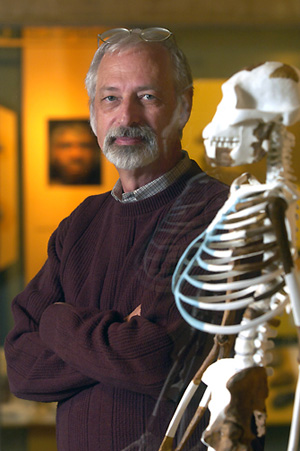While a media outlets around the world are touting a nearly two-decade-old find as the oldest known skeleton of a potential human ancestor, creationists point out that even the team of researchers who unveiled the reconstructed fossil cannot refute the possibility that it might be simply that of an extinct ape.
“Based on our first look … the facts seem solidly behind the idea that Ardi was a quadrupedal ape with relatively little in common with humans (i.e., no more than most apes),” wrote staff members at the apologetics ministry Answers in Genesis, referring to the skeleton by its nickname.
“[T]he key basis for the alleged Ardi–human link (which even the authors are hesitant to confirm) is the idea that it walked upright-an idea that even evolutionists have criticized,” the ministry added. “And we can’t forget that all of these conclusions are inferred from digital reconstructions and fallible reconstructions of bones that were in very bad shape.
“As far as we’re concerned, the evolutionary ‘threat’ to creationists from Ardi is no more than that posed by Ida: viz., none,” they concluded, referring to the 47-million-year-old fossil touted earlier this year as the “missing link” between prosimian primates and anthropoid primates.
Last Thursday, a multinational team of 47 researchers, who have been studying the bones of “Ardi” since they were discovered in the early 1990s, presented them as those belonging to the oldest known “potential human ancestor,” Ardipithecus ramidus.
The skeleton, found in Ethiopia and thought to be 4.4-million years old, includes most of the skull and teeth, as well as the pelvis, hands, and feet – parts that the researchers say reveal an "intermediate" form of upright walking, considered a hallmark of hominids.
“This species … resolves many uncertainties about early human evolution, including the nature of the last common ancestor that we shared with the line leading to living chimpanzees and bonobos," commented team member Tim D. White, director of the Human Evolution Research Center at the University of California, Berkeley.
According to the Institute for Creation Research, however, placing Ardi into human ancestry creates more problems than it solves.
"For example, Ardipithecus' body structure shows no objective or undisputable transition toward uniquely human features," the creationist group stated.
"Speculation and evolutionary guesswork, not scientific observations, are offered to bridge these gaps," it added.
And, as Answers in Genesis noted, Ardi is a partial skeleton put together based on the bone fragments of at least 35 sets of skeletons – many of which were in such bad shape that it took 15 years before the research team could fully analyze and publish its findings on the combined skeleton.
“[A]s a starting point, creationists should remember that - as with many fossils - the state of preservation is far less perfect than what media images and ‘reconstructions’ portray,” the ministry pointed out.
Furthermore, Ardi’s feet had opposable big toes and lacked arches, which suggests that she – or more correctly, they – could not walk or run for long distances and also suggests that she did not walk upright as some believe she may have.
“This is a fascinating skeleton, but based on what they present, the evidence for bipedality is limited at best,” anatomist William Jungers of Stony Brook University told National Geographic News.
“Divergent big toes are associated with grasping, and this has one of the most divergent big toes you can imagine. Why would an animal fully adapted to support its weight on its forelimbs in the trees elect to walk bipedally on the ground?” he posed.
Based on these and other points, Answers in Genesis suggested that the ongoing pressure for scientists to find something of “evolutionary significance” could have led to a systematic incentive to make a huge deal out of otherwise “trivial fossils.”
“We must admit that from our perspective, we’re growing desensitized to the fervor that increasingly surrounds each new fossil discovery claimed to support evolution,” the ministry expressed.
“[T]he concerted release of so many papers on Ardi and the corresponding hubbub seems to perhaps be more about attention-seeking than about science,” it added.
In the 11 papers published in the Oct. 2 issue of Science magazine and online, the team of 47 researchers revealed their findings and described how Ardipithecus ramidus might have looked and moved, but, as the Institute for Creation Research noted, used the word “probably” about 78 times and “suggest,” “suggesting,” “suggestive,” or “suggests” 117 times, among "other terms that are associated with an unsubstantiated story rather than a scientific description."
The publishing of the papers happens to coincide with the 200th anniversary year of the birth of 19th-century naturalist Charles Darwin, who introduced the theory that all species of life have evolved over time from common ancestors through a process of natural selection.
Although in the scientific community there is essentially universal agreement that the evidence of evolution is overwhelming, and the scientific consensus supporting the modern evolutionary synthesis is nearly absolute, creationists have asserted that there is a significant scientific controversy and disagreement over the validity of evolution.
According to the Gallup organization, which has polled U.S. adults about their beliefs on evolution and creation since 1982, 44 percent of Americans surveyed last year said they believe God created man pretty much in his present form at one time within the last 10,000 years.
Thirty-six percent, meanwhile, said they believe that man has developed over millions of years from less advanced forms of life, but that God guided the process, including man's creation.
Only 14 percent believe man has developed over millions of years from less advanced forms of life and that God had no part in the process.
The figures have remained relatively the same over the past nearly three-decades, with the last group having shown a significant – though slight – increase.

















